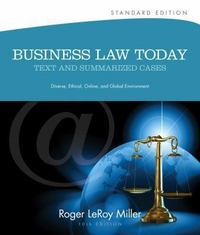Mortgage Foreclosure. In January 2003, Gary Ryder and Washington Mutual Bank, F.A., executed a note in which
Question:
Mortgage Foreclosure. In January 2003, Gary Ryder and Washington Mutual Bank, F.A., executed a note in which Ryder promised to pay $2,450,000, plus interest at a rate that could vary from month to month. The amount of the first payment was $10,933. The note was to be paid in full by February 1, 2033. A mortgage on Ryder’s real property at 345 Round Hill Road in Greenwich, Connecticut, in favor of the bank secured his obligations under the note. The note and mortgage required Ryder to pay the taxes on the property, which he did not do in 2004 and 2005. The bank notified him that he was in default and, when he failed to act, paid
$50,095.92 in taxes, penalties, interest, and fees. Other disputes arose between the parties, and Ryder filed a suit against the bank, alleging, in part, breach of contract. He charged, among other things, that some of his timely payments were not processed and were subjected to incorrect late fees, forcing him to make excessive payments and ultimately resulting in “non-payment by Ryder.” The bank filed a counterclaim, seeking to foreclose on the mortgage. What should a creditor be required to prove to foreclose on mortgaged property?
What would be a debtor’s most effective defense? Which party in this case is likely to prevail on the bank’s counterclaim?
Why? [Ryder v. Washington Mutual Bank, F.A., 501 F.Supp.2d 311 (D.Conn. 2007)] (See pages 581–586.)
Step by Step Answer:






